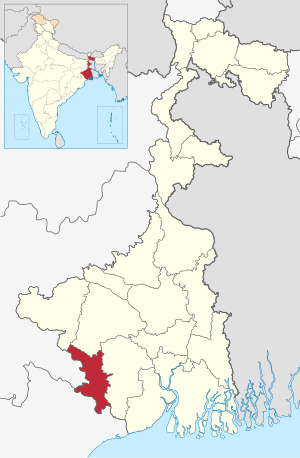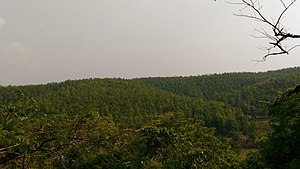This article needs additional citations for verification. (July 2020) |
Jhargram | |
|---|---|
|
Clockwise from top: View from the top of Belpahari, Rameshwar Temple, Jhargram Palace, Kanak Durga Temple, Chilkigarh Rajbari | |
 Location of Jhargram district in West Bengal | |
| Coordinates: 22°27′N 86°59′E / 22.45°N 86.98°E | |
| Country | |
| State | |
| Division | Medinipur division |
| Headquarters | Jhargram |
| Government | |
| • Subdivisions | Jhargram Sadar |
| • CD Blocks | Jhargram, Jamboni, Binpur I, Binpur II, Gopiballavpur I, Gopiballavpur II, Sankrail, Nayagram |
| • Lok Sabha constituencies | Jhargram |
| • Vidhan Sabha constituencies | Jhargram, Gopiballavpur, Nayagram, Binpur |
| Area | |
| • Total | 3,037.90 km2 (1,172.94 sq mi) |
| Population (2011) | |
| • Total | 1,136,548 |
| • Density | 370/km2 (970/sq mi) |
| • Urban | 61,712 |
| Demographics | |
| • Literacy | 89.2 per cent |
| • Sex ratio | 949 ♂/♀ |
| Languages | |
| • Official | Bengali[1][2] |
| • Additional official | English[1] |
| Time zone | UTC+05:30 (IST) |
| Website | jhargram |
Jhargram is a district in the state of West Bengal, India.The district lies between the Kangsabati River in the north and the Subarnarekha in the south. Jhargram has one of the lowest population densities among the districts of West Bengal, with almost all its population living in rural areas. It is a popular tourist destination known for its sal forests, elephants, ancient temples and royal palaces.[3] The district was formed on 4 April 2017, after bifurcation from the Paschim Medinipur district as the 22nd district of West Bengal.[4] The district has its headquarters at Jhargram.
- ^ a b "Fact and Figures". Wb.gov.in. Retrieved 5 July 2019.
- ^ "52nd Report of the Commissioner for Linguistic Minorities in India" (PDF). Nclm.nic.in. Ministry of Minority Affairs. p. 85. Archived from the original (PDF) on 25 May 2017. Retrieved 5 July 2019.
- ^ "Tourism - Paschim Medinipur". Archived from the original on 28 September 2015. Retrieved 18 April 2017.
- ^ "Jhargram to be state's 22nd district on April 4". Millennium Post. 22 March 2017. Retrieved 4 April 2017.





